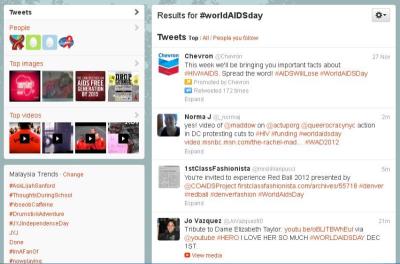By NIKI CHEONG
alltherage@thestar.com.my
A COUPLE of weeks ago, I was informed that my friend – Paul (not his real name) – in London was recently diagnosed with HIV. The person who told me, however, did not personally know Paul, but had read the news on his Twitter feed instead.
This led to a long discussion and I was told that following Paul’s revelation, many people were talking about safe sex and HIV on Twitter afterwards.
I have, for over a decade, tried to be as involved as I could in spreading awareness on HIV/AIDS-related causes but sometimes, I fall into complacency and assume that other like-minded people would be as informed as I was over this issue.
But that conversation over social networks was a timely reminder that that wasn’t the case.
While I have long been an advocate of social networking, there have been many disheartening occurrences over the past few years – particularly those involving the dissemination of misinformation and disinformation, especially during crises.
Each time we celebrated the victory of a social networking site like Twitter, for example, breaking news quicker than traditional news platforms, we also have had to wince at the number of related fake tweets or “Photoshopped” pictures that were shared.
The HIV/AIDS discussions after Paul’s revelation is a good example that social networks are diverse enough to work differently in a variety of situations – especially for long-term campaigns where education and awareness is as important as research and medical discovery.
We have made a lot of progress both culturally, socially and medically since the early 80s, when stories of AIDS patients (and related deaths) first became public; but unfortunately, there still are many ignorant people out there.
We still have folks who believe that HIV and AIDS are linked to an individual’s sexuality, as well as those who go online promoting unsafe sex (even using particular hashtags on Twitter), despite being aware of its consequences.
However, the Internet can play a role in educating these misinformed but social network-savvy people.
Over the years, we have already seen a variety of creative campaigns run around the world to spread awareness and educate people about HIV/AIDS.
A couple of years ago, R.AGE ran a campaign to get young people to document, via Twitter, their first-time experience testing for sexual transmitted diseases.
Then there was also the #AIDSaware campaign, organised by the now defunct local social network Ruumz and PT Foundation.
The campaign brought together a number of personalities, including myself, to help spread the awareness through a video commercial, photo exhibition and our respective social networks.
More recently, the Malaysian AIDS Council collaborated with actor Aaron Aziz to set up the Red Ribbon Youth Club (fb.me/redribbonyouthclub) on Facebook to generate youth engagement while at the same time spreading awareness about the disease.
It is in these sorts of social casino online networking activities that discourse about HIV/AIDS awareness can happen, and it shouldn’t matter if it reaches out to small or big groups of people (both off and online).
So, in conjunction with World AIDS Day tomorrow, how can you be part of this movement and help generate discourse?
The easiest way is using the tools that have already been created for us and that we are most familiar with – social network sites like Facebook and Twitter.
Many of you would already have encountered profiles sporting the Red Ribbon (the international symbol for HIV/AIDS awareness) Twibbon (twibbon.com/support/world-aids-day-worldaidsday), and you can start the conversation within your respective networks by putting that on your avatars.
Sites like avert.org have existed for more than a decade with updated information about HIV and AIDS, while UNAIDS have taken to Twitter to spread the word (twitter.com/UNAIDS).
Then, there are also blogs (such as ukpositivelad.com) maintained by those living with HIV – who have chosen to share their experiences to raise awareness and help reduce the stigma attached to the disease.
For many people, learning in a classroom setting is often not very exciting but with social networking, there is no excuse for us not to learn and share our knowledge, especially for a cause like this.
Pardon the cliché, but it is in situations like these that you can make a difference – not just to your own lives (by learning how to take care of yourself and treat other people) but also to your network of friends and followers.
Niki has just completed his MA Digital Culture and Society at King’s College London. Connect with him online at blog.nikicheong.com and on Twitter via @nikicheong.


Tell us what you think!